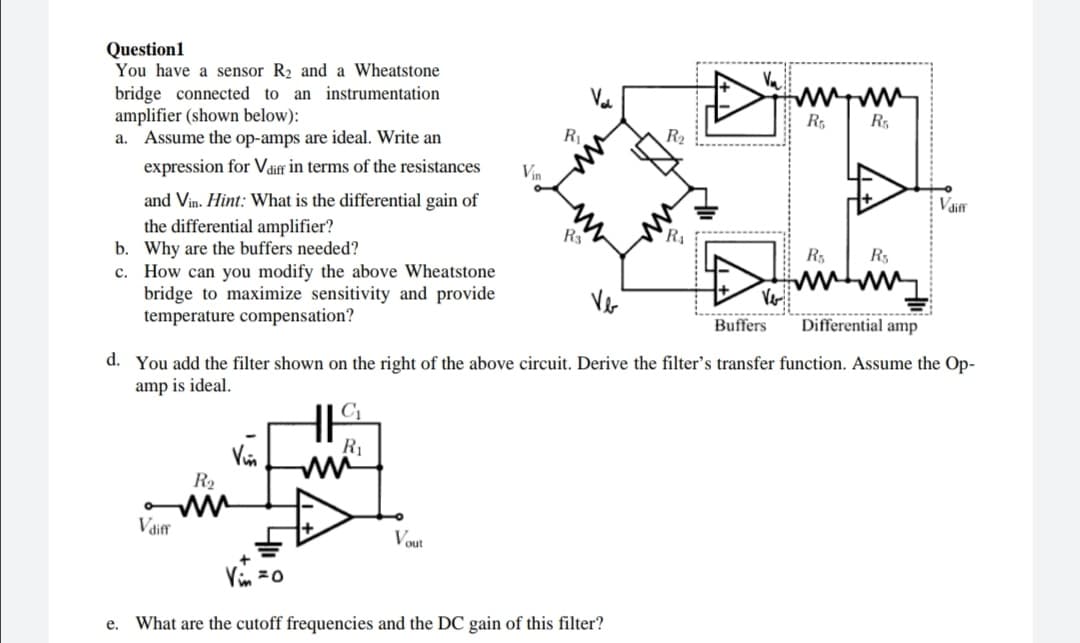Question1 You have a sensor R₂ and a Wheatstone bridge connected to an instrumentation amplifier (shown below): www.ww R5 R₁ a. Assume the op-amps are ideal. Write an expression for Vdiff in terms of the resistances and Vin. Hint: What is the differential gain of the differential amplifier? b. Why are the buffers needed? R₁ R₁ c. How can you modify the above Wheatstone bridge to maximize sensitivity and provide temperature compensation? Vb Buffers Differential amp d. You add the filter shown on the right of the above circuit. Derive the filter's transfer function. Assume the Op- amp is ideal. HIC R₁ Vin R₂ ww Vdiff Vout Vin = 0 e. What are the cutoff frequencies and the DC gain of this filter? Vin R₁ R3 R₂ R Vdiff
Question1 You have a sensor R₂ and a Wheatstone bridge connected to an instrumentation amplifier (shown below): www.ww R5 R₁ a. Assume the op-amps are ideal. Write an expression for Vdiff in terms of the resistances and Vin. Hint: What is the differential gain of the differential amplifier? b. Why are the buffers needed? R₁ R₁ c. How can you modify the above Wheatstone bridge to maximize sensitivity and provide temperature compensation? Vb Buffers Differential amp d. You add the filter shown on the right of the above circuit. Derive the filter's transfer function. Assume the Op- amp is ideal. HIC R₁ Vin R₂ ww Vdiff Vout Vin = 0 e. What are the cutoff frequencies and the DC gain of this filter? Vin R₁ R3 R₂ R Vdiff
Introductory Circuit Analysis (13th Edition)
13th Edition
ISBN:9780133923605
Author:Robert L. Boylestad
Publisher:Robert L. Boylestad
Chapter1: Introduction
Section: Chapter Questions
Problem 1P: Visit your local library (at school or home) and describe the extent to which it provides literature...
Related questions
Question

Transcribed Image Text:Question1
You have a sensor R₂ and a Wheatstone
bridge connected to an instrumentation
amplifier (shown below):
www.ww
R5
R5
a. Assume the op-amps are ideal. Write an
expression for Vdiff in terms of the resistances
and Vin. Hint: What is the differential gain of
the differential amplifier?
R3
b.
Why are the buffers needed?
R₁
R₁
c. How can you modify the above Wheatstone
bridge to maximize sensitivity and provide
temperature compensation?
Buffers
Differential amp
d. You add the filter shown on the right of the above circuit. Derive the filter's transfer function. Assume the Op-
amp is ideal.
HIC
R₁
Vin
R₂
ww
Vdiff
Vout
Vin = 0
e. What are the cutoff frequencies and the DC gain of this filter?
Vin
R₁
R₂
R
V₂
Vdiff
Expert Solution
This question has been solved!
Explore an expertly crafted, step-by-step solution for a thorough understanding of key concepts.
Step by step
Solved in 3 steps with 2 images

Knowledge Booster
Learn more about
Need a deep-dive on the concept behind this application? Look no further. Learn more about this topic, electrical-engineering and related others by exploring similar questions and additional content below.Recommended textbooks for you

Introductory Circuit Analysis (13th Edition)
Electrical Engineering
ISBN:
9780133923605
Author:
Robert L. Boylestad
Publisher:
PEARSON

Delmar's Standard Textbook Of Electricity
Electrical Engineering
ISBN:
9781337900348
Author:
Stephen L. Herman
Publisher:
Cengage Learning

Programmable Logic Controllers
Electrical Engineering
ISBN:
9780073373843
Author:
Frank D. Petruzella
Publisher:
McGraw-Hill Education

Introductory Circuit Analysis (13th Edition)
Electrical Engineering
ISBN:
9780133923605
Author:
Robert L. Boylestad
Publisher:
PEARSON

Delmar's Standard Textbook Of Electricity
Electrical Engineering
ISBN:
9781337900348
Author:
Stephen L. Herman
Publisher:
Cengage Learning

Programmable Logic Controllers
Electrical Engineering
ISBN:
9780073373843
Author:
Frank D. Petruzella
Publisher:
McGraw-Hill Education

Fundamentals of Electric Circuits
Electrical Engineering
ISBN:
9780078028229
Author:
Charles K Alexander, Matthew Sadiku
Publisher:
McGraw-Hill Education

Electric Circuits. (11th Edition)
Electrical Engineering
ISBN:
9780134746968
Author:
James W. Nilsson, Susan Riedel
Publisher:
PEARSON

Engineering Electromagnetics
Electrical Engineering
ISBN:
9780078028151
Author:
Hayt, William H. (william Hart), Jr, BUCK, John A.
Publisher:
Mcgraw-hill Education,